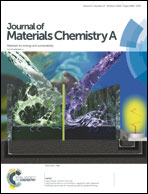Highly selective and sensitive chemoresistive humidity sensors based on rGO/MoS2 van der Waals composites†
Abstract
Reduced graphene oxide (rGO) and MoS2, the most representative two-dimensional (2D) materials, are receiving significant attention for the fabrication of sensing devices owing to their high surface area, many abundant sites, and excellent mechanical flexibility. Herein, we demonstrated chemoresistive humidity sensors with fast response, excellent selectivity, and ultrahigh sensitivity based on 2D rGO and 2D MoS2 hybrid composites (RGMSs). The RGMSs were fabricated by simple ultrasonication without the addition of additives and additional heating. Compared to pristine rGO, the RGMS exhibited a 200 times higher response to humidity at room temperature. The significant enhancement in the sensing performance of the composite was attributed to electronic sensitization due to p–n heterojunction formation and porous structures between rGO and MoS2. The synergistic combination of rGO and MoS2 could be applied to construct a flexible humidity sensor. The sensing performance of an RGMS flexible device remains the same before and after bending; this indicates that the use of rGO and MoS2 is a viable new and simple strategy to realize a humidity sensor for use in wearable electronics.



 Please wait while we load your content...
Please wait while we load your content...